Personal and Professional Development Report: Self-Management Skills
VerifiedAdded on 2020/01/15
|10
|3495
|144
Report
AI Summary
This report provides an in-depth analysis of personal and professional development (PPD), focusing on key skills such as self-management, self-development, effective relationships, leadership, and organizational development. The introduction highlights the importance of continuous learning and adapting to workplace changes. The report details the benefits of self-management, including goal setting and time management, and explores strategies like meta-learning, strategic learning, and motivational autonomous learning. It then examines self-development, emphasizing motivation and the application of content and process theories. The report further discusses building effective relationships through communication, detailing both verbal and non-verbal aspects. Leadership skills are also explored, with an overview of trait, behavioral, contingency, charismatic, and leader-member exchange theories. Finally, organizational development is covered, with an emphasis on engaging others and maintaining professionalism. The report concludes with a summary of the key takeaways and emphasizes the importance of PPD for career growth and work-life balance.
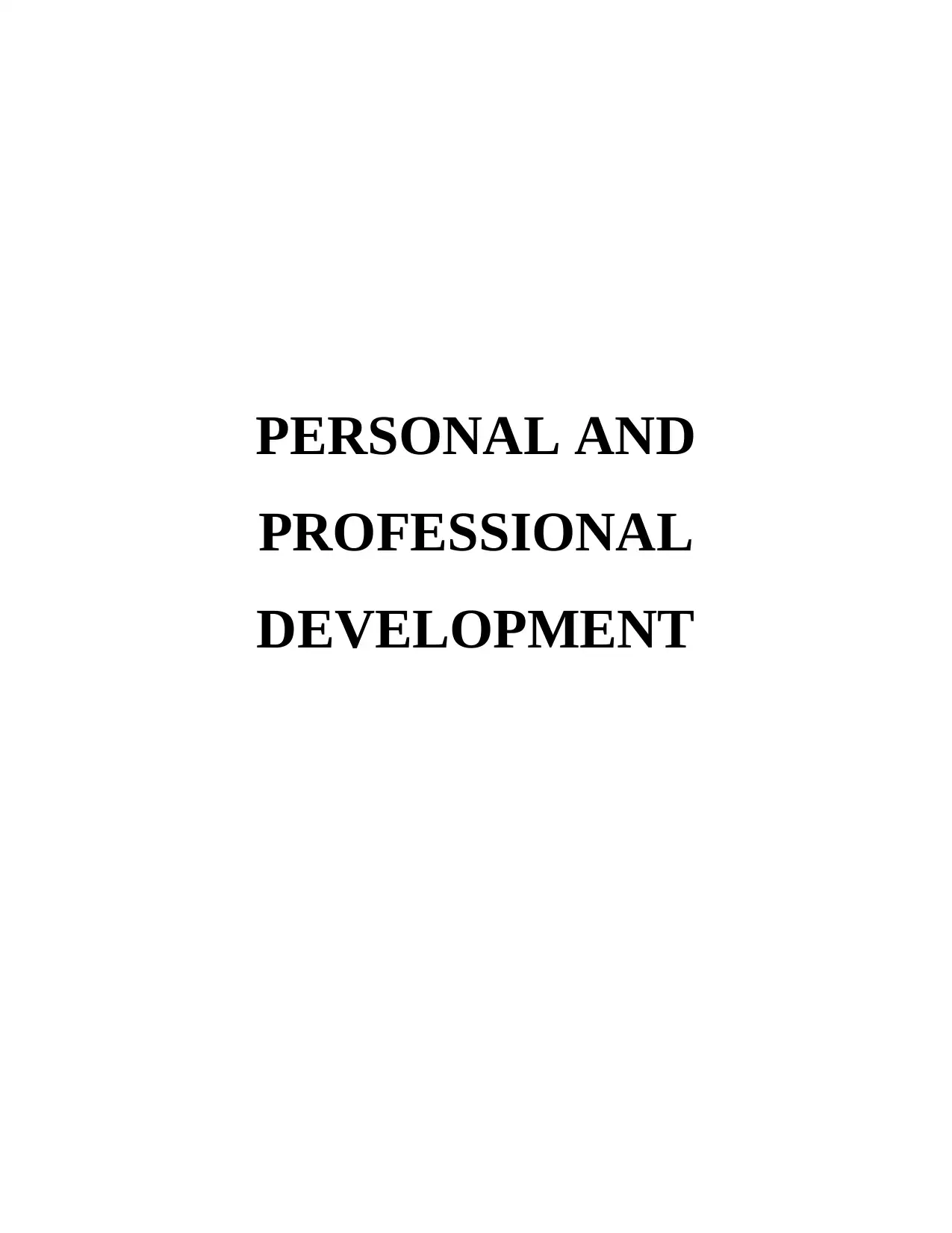
PERSONAL AND
PROFESSIONAL
DEVELOPMENT
PROFESSIONAL
DEVELOPMENT
Paraphrase This Document
Need a fresh take? Get an instant paraphrase of this document with our AI Paraphraser
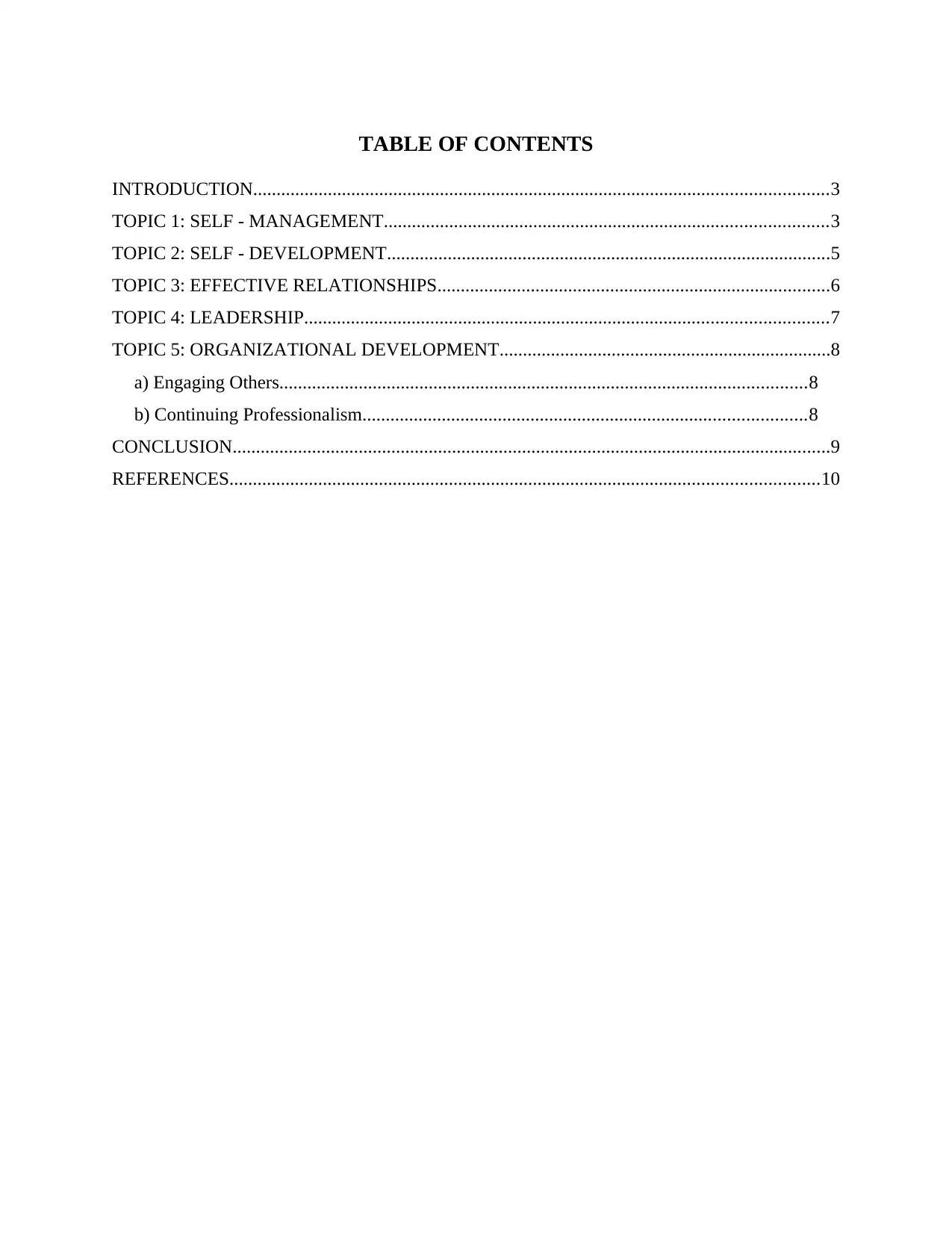
TABLE OF CONTENTS
INTRODUCTION...........................................................................................................................3
TOPIC 1: SELF - MANAGEMENT...............................................................................................3
TOPIC 2: SELF - DEVELOPMENT...............................................................................................5
TOPIC 3: EFFECTIVE RELATIONSHIPS....................................................................................6
TOPIC 4: LEADERSHIP................................................................................................................7
TOPIC 5: ORGANIZATIONAL DEVELOPMENT.......................................................................8
a) Engaging Others.................................................................................................................8
b) Continuing Professionalism...............................................................................................8
CONCLUSION................................................................................................................................9
REFERENCES..............................................................................................................................10
INTRODUCTION...........................................................................................................................3
TOPIC 1: SELF - MANAGEMENT...............................................................................................3
TOPIC 2: SELF - DEVELOPMENT...............................................................................................5
TOPIC 3: EFFECTIVE RELATIONSHIPS....................................................................................6
TOPIC 4: LEADERSHIP................................................................................................................7
TOPIC 5: ORGANIZATIONAL DEVELOPMENT.......................................................................8
a) Engaging Others.................................................................................................................8
b) Continuing Professionalism...............................................................................................8
CONCLUSION................................................................................................................................9
REFERENCES..............................................................................................................................10
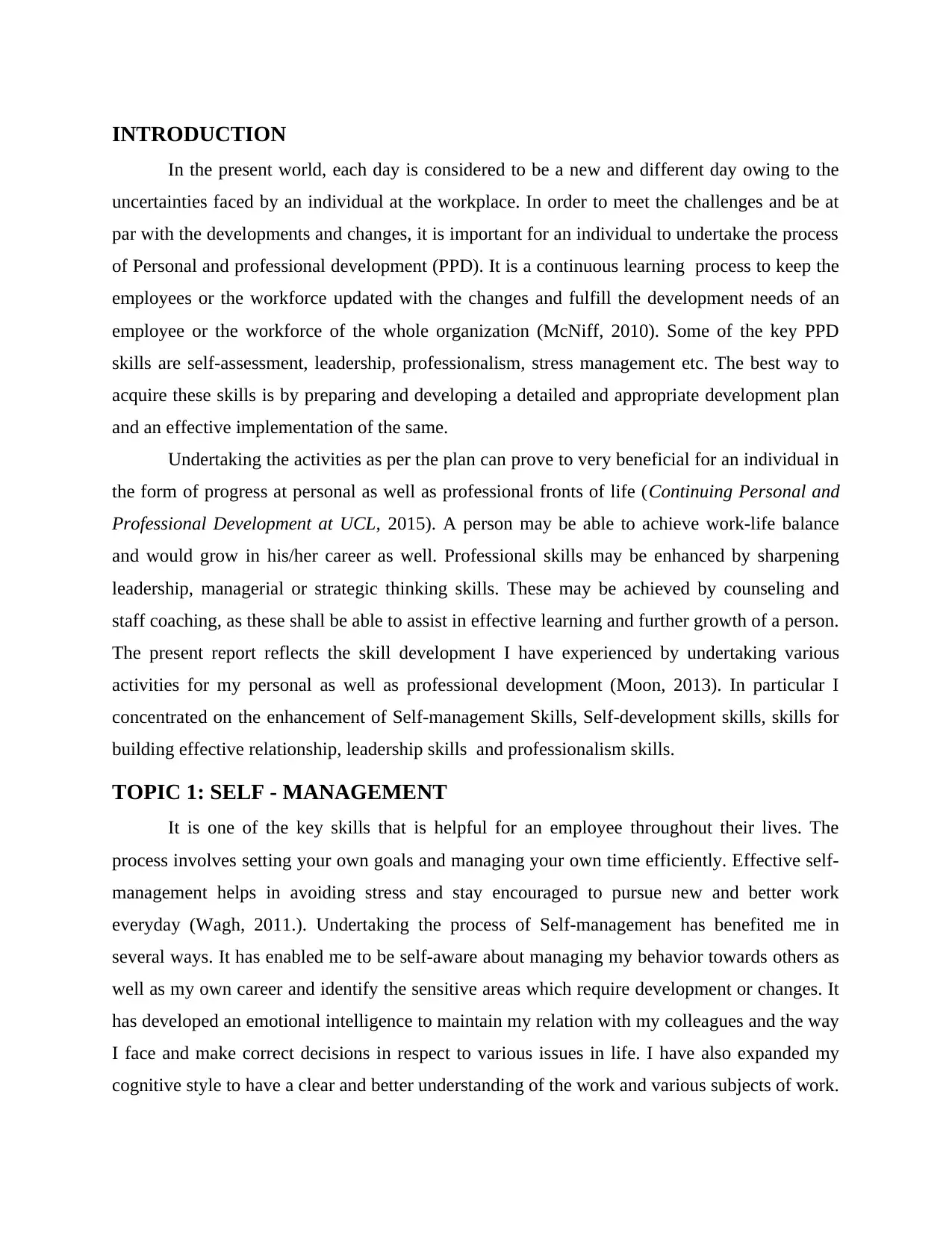
INTRODUCTION
In the present world, each day is considered to be a new and different day owing to the
uncertainties faced by an individual at the workplace. In order to meet the challenges and be at
par with the developments and changes, it is important for an individual to undertake the process
of Personal and professional development (PPD). It is a continuous learning process to keep the
employees or the workforce updated with the changes and fulfill the development needs of an
employee or the workforce of the whole organization (McNiff, 2010). Some of the key PPD
skills are self-assessment, leadership, professionalism, stress management etc. The best way to
acquire these skills is by preparing and developing a detailed and appropriate development plan
and an effective implementation of the same.
Undertaking the activities as per the plan can prove to very beneficial for an individual in
the form of progress at personal as well as professional fronts of life (Continuing Personal and
Professional Development at UCL, 2015). A person may be able to achieve work-life balance
and would grow in his/her career as well. Professional skills may be enhanced by sharpening
leadership, managerial or strategic thinking skills. These may be achieved by counseling and
staff coaching, as these shall be able to assist in effective learning and further growth of a person.
The present report reflects the skill development I have experienced by undertaking various
activities for my personal as well as professional development (Moon, 2013). In particular I
concentrated on the enhancement of Self-management Skills, Self-development skills, skills for
building effective relationship, leadership skills and professionalism skills.
TOPIC 1: SELF - MANAGEMENT
It is one of the key skills that is helpful for an employee throughout their lives. The
process involves setting your own goals and managing your own time efficiently. Effective self-
management helps in avoiding stress and stay encouraged to pursue new and better work
everyday (Wagh, 2011.). Undertaking the process of Self-management has benefited me in
several ways. It has enabled me to be self-aware about managing my behavior towards others as
well as my own career and identify the sensitive areas which require development or changes. It
has developed an emotional intelligence to maintain my relation with my colleagues and the way
I face and make correct decisions in respect to various issues in life. I have also expanded my
cognitive style to have a clear and better understanding of the work and various subjects of work.
In the present world, each day is considered to be a new and different day owing to the
uncertainties faced by an individual at the workplace. In order to meet the challenges and be at
par with the developments and changes, it is important for an individual to undertake the process
of Personal and professional development (PPD). It is a continuous learning process to keep the
employees or the workforce updated with the changes and fulfill the development needs of an
employee or the workforce of the whole organization (McNiff, 2010). Some of the key PPD
skills are self-assessment, leadership, professionalism, stress management etc. The best way to
acquire these skills is by preparing and developing a detailed and appropriate development plan
and an effective implementation of the same.
Undertaking the activities as per the plan can prove to very beneficial for an individual in
the form of progress at personal as well as professional fronts of life (Continuing Personal and
Professional Development at UCL, 2015). A person may be able to achieve work-life balance
and would grow in his/her career as well. Professional skills may be enhanced by sharpening
leadership, managerial or strategic thinking skills. These may be achieved by counseling and
staff coaching, as these shall be able to assist in effective learning and further growth of a person.
The present report reflects the skill development I have experienced by undertaking various
activities for my personal as well as professional development (Moon, 2013). In particular I
concentrated on the enhancement of Self-management Skills, Self-development skills, skills for
building effective relationship, leadership skills and professionalism skills.
TOPIC 1: SELF - MANAGEMENT
It is one of the key skills that is helpful for an employee throughout their lives. The
process involves setting your own goals and managing your own time efficiently. Effective self-
management helps in avoiding stress and stay encouraged to pursue new and better work
everyday (Wagh, 2011.). Undertaking the process of Self-management has benefited me in
several ways. It has enabled me to be self-aware about managing my behavior towards others as
well as my own career and identify the sensitive areas which require development or changes. It
has developed an emotional intelligence to maintain my relation with my colleagues and the way
I face and make correct decisions in respect to various issues in life. I have also expanded my
cognitive style to have a clear and better understanding of the work and various subjects of work.
⊘ This is a preview!⊘
Do you want full access?
Subscribe today to unlock all pages.

Trusted by 1+ million students worldwide
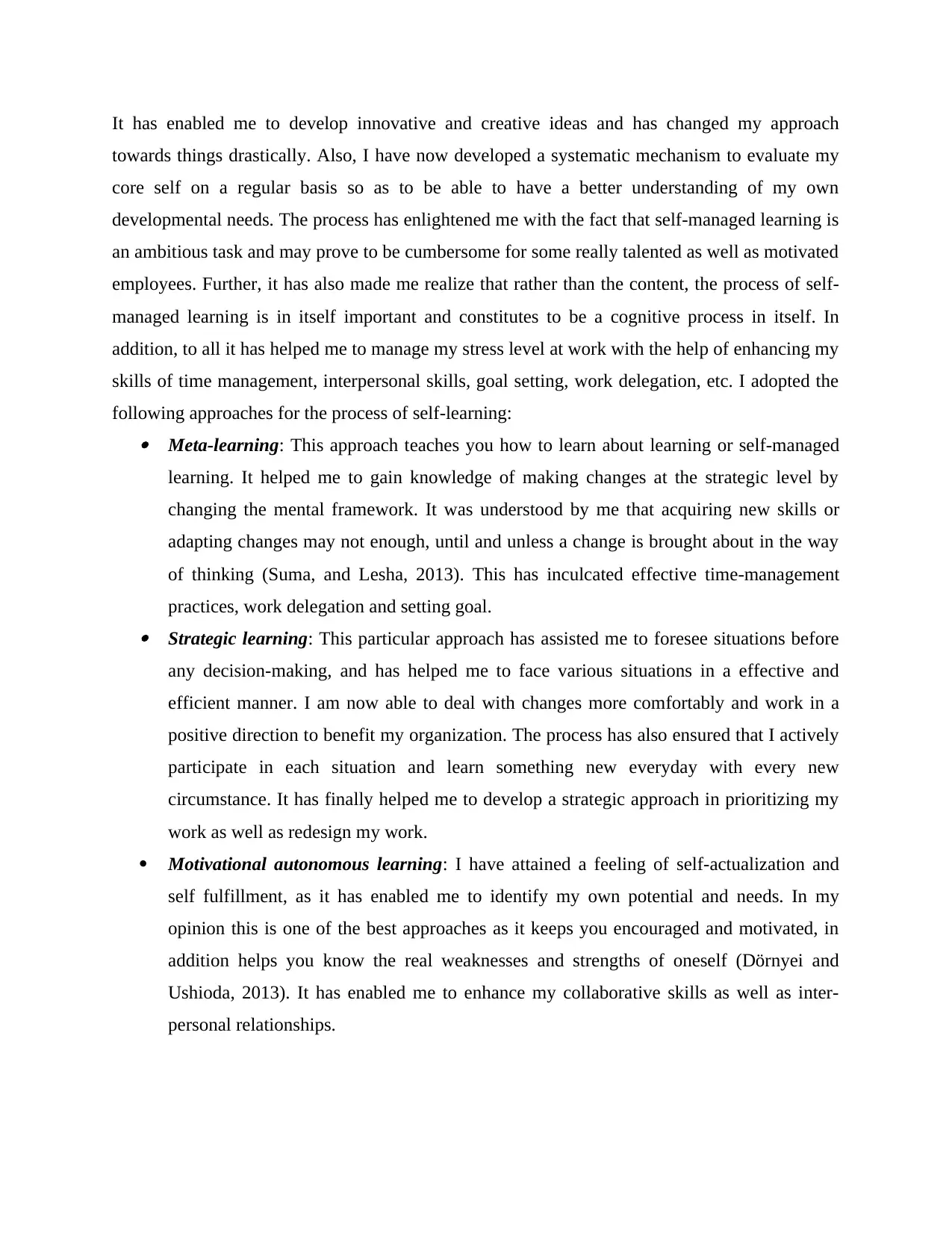
It has enabled me to develop innovative and creative ideas and has changed my approach
towards things drastically. Also, I have now developed a systematic mechanism to evaluate my
core self on a regular basis so as to be able to have a better understanding of my own
developmental needs. The process has enlightened me with the fact that self-managed learning is
an ambitious task and may prove to be cumbersome for some really talented as well as motivated
employees. Further, it has also made me realize that rather than the content, the process of self-
managed learning is in itself important and constitutes to be a cognitive process in itself. In
addition, to all it has helped me to manage my stress level at work with the help of enhancing my
skills of time management, interpersonal skills, goal setting, work delegation, etc. I adopted the
following approaches for the process of self-learning: Meta-learning: This approach teaches you how to learn about learning or self-managed
learning. It helped me to gain knowledge of making changes at the strategic level by
changing the mental framework. It was understood by me that acquiring new skills or
adapting changes may not enough, until and unless a change is brought about in the way
of thinking (Suma, and Lesha, 2013). This has inculcated effective time-management
practices, work delegation and setting goal. Strategic learning: This particular approach has assisted me to foresee situations before
any decision-making, and has helped me to face various situations in a effective and
efficient manner. I am now able to deal with changes more comfortably and work in a
positive direction to benefit my organization. The process has also ensured that I actively
participate in each situation and learn something new everyday with every new
circumstance. It has finally helped me to develop a strategic approach in prioritizing my
work as well as redesign my work.
Motivational autonomous learning: I have attained a feeling of self-actualization and
self fulfillment, as it has enabled me to identify my own potential and needs. In my
opinion this is one of the best approaches as it keeps you encouraged and motivated, in
addition helps you know the real weaknesses and strengths of oneself (Dörnyei and
Ushioda, 2013). It has enabled me to enhance my collaborative skills as well as inter-
personal relationships.
towards things drastically. Also, I have now developed a systematic mechanism to evaluate my
core self on a regular basis so as to be able to have a better understanding of my own
developmental needs. The process has enlightened me with the fact that self-managed learning is
an ambitious task and may prove to be cumbersome for some really talented as well as motivated
employees. Further, it has also made me realize that rather than the content, the process of self-
managed learning is in itself important and constitutes to be a cognitive process in itself. In
addition, to all it has helped me to manage my stress level at work with the help of enhancing my
skills of time management, interpersonal skills, goal setting, work delegation, etc. I adopted the
following approaches for the process of self-learning: Meta-learning: This approach teaches you how to learn about learning or self-managed
learning. It helped me to gain knowledge of making changes at the strategic level by
changing the mental framework. It was understood by me that acquiring new skills or
adapting changes may not enough, until and unless a change is brought about in the way
of thinking (Suma, and Lesha, 2013). This has inculcated effective time-management
practices, work delegation and setting goal. Strategic learning: This particular approach has assisted me to foresee situations before
any decision-making, and has helped me to face various situations in a effective and
efficient manner. I am now able to deal with changes more comfortably and work in a
positive direction to benefit my organization. The process has also ensured that I actively
participate in each situation and learn something new everyday with every new
circumstance. It has finally helped me to develop a strategic approach in prioritizing my
work as well as redesign my work.
Motivational autonomous learning: I have attained a feeling of self-actualization and
self fulfillment, as it has enabled me to identify my own potential and needs. In my
opinion this is one of the best approaches as it keeps you encouraged and motivated, in
addition helps you know the real weaknesses and strengths of oneself (Dörnyei and
Ushioda, 2013). It has enabled me to enhance my collaborative skills as well as inter-
personal relationships.
Paraphrase This Document
Need a fresh take? Get an instant paraphrase of this document with our AI Paraphraser
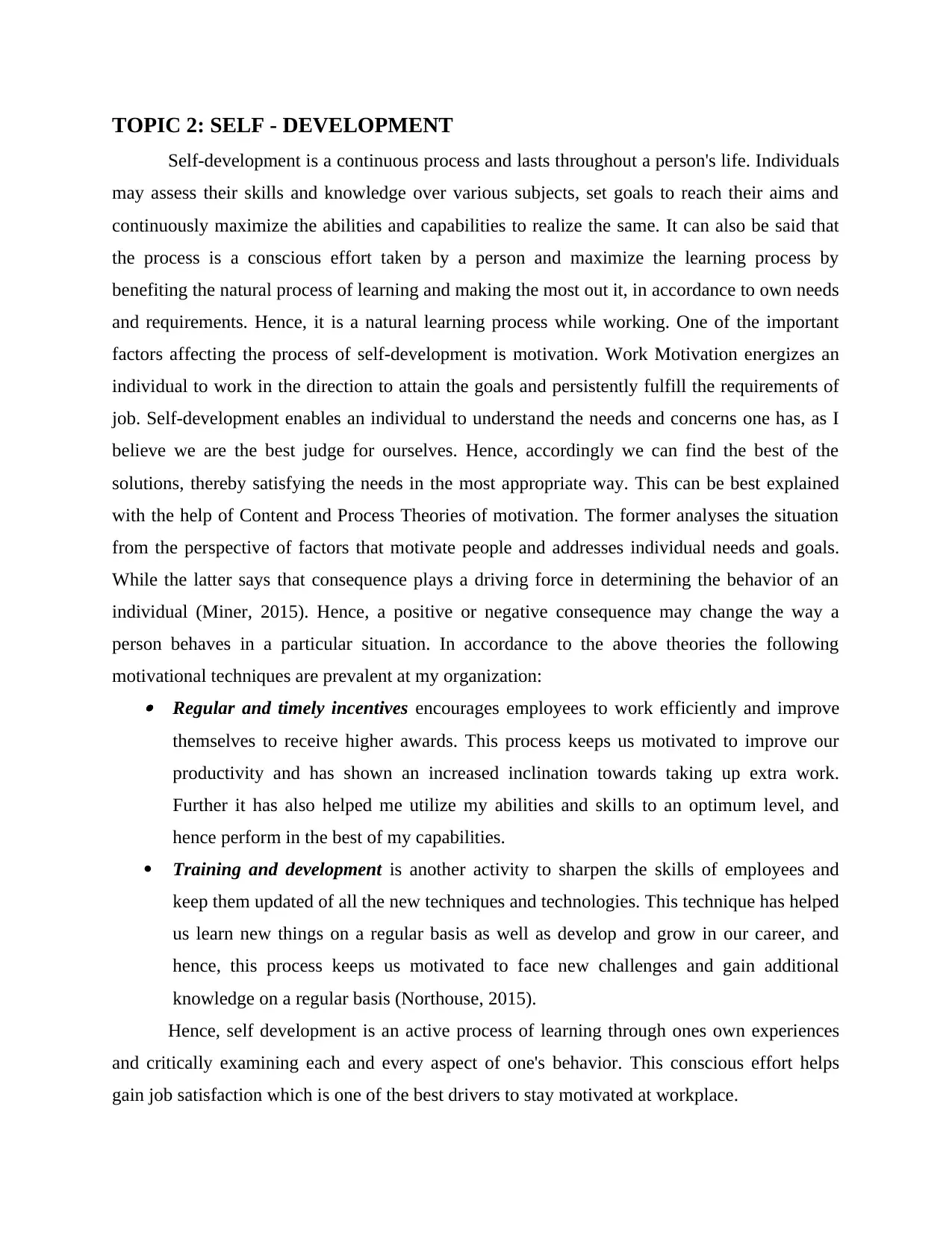
TOPIC 2: SELF - DEVELOPMENT
Self-development is a continuous process and lasts throughout a person's life. Individuals
may assess their skills and knowledge over various subjects, set goals to reach their aims and
continuously maximize the abilities and capabilities to realize the same. It can also be said that
the process is a conscious effort taken by a person and maximize the learning process by
benefiting the natural process of learning and making the most out it, in accordance to own needs
and requirements. Hence, it is a natural learning process while working. One of the important
factors affecting the process of self-development is motivation. Work Motivation energizes an
individual to work in the direction to attain the goals and persistently fulfill the requirements of
job. Self-development enables an individual to understand the needs and concerns one has, as I
believe we are the best judge for ourselves. Hence, accordingly we can find the best of the
solutions, thereby satisfying the needs in the most appropriate way. This can be best explained
with the help of Content and Process Theories of motivation. The former analyses the situation
from the perspective of factors that motivate people and addresses individual needs and goals.
While the latter says that consequence plays a driving force in determining the behavior of an
individual (Miner, 2015). Hence, a positive or negative consequence may change the way a
person behaves in a particular situation. In accordance to the above theories the following
motivational techniques are prevalent at my organization: Regular and timely incentives encourages employees to work efficiently and improve
themselves to receive higher awards. This process keeps us motivated to improve our
productivity and has shown an increased inclination towards taking up extra work.
Further it has also helped me utilize my abilities and skills to an optimum level, and
hence perform in the best of my capabilities.
Training and development is another activity to sharpen the skills of employees and
keep them updated of all the new techniques and technologies. This technique has helped
us learn new things on a regular basis as well as develop and grow in our career, and
hence, this process keeps us motivated to face new challenges and gain additional
knowledge on a regular basis (Northouse, 2015).
Hence, self development is an active process of learning through ones own experiences
and critically examining each and every aspect of one's behavior. This conscious effort helps
gain job satisfaction which is one of the best drivers to stay motivated at workplace.
Self-development is a continuous process and lasts throughout a person's life. Individuals
may assess their skills and knowledge over various subjects, set goals to reach their aims and
continuously maximize the abilities and capabilities to realize the same. It can also be said that
the process is a conscious effort taken by a person and maximize the learning process by
benefiting the natural process of learning and making the most out it, in accordance to own needs
and requirements. Hence, it is a natural learning process while working. One of the important
factors affecting the process of self-development is motivation. Work Motivation energizes an
individual to work in the direction to attain the goals and persistently fulfill the requirements of
job. Self-development enables an individual to understand the needs and concerns one has, as I
believe we are the best judge for ourselves. Hence, accordingly we can find the best of the
solutions, thereby satisfying the needs in the most appropriate way. This can be best explained
with the help of Content and Process Theories of motivation. The former analyses the situation
from the perspective of factors that motivate people and addresses individual needs and goals.
While the latter says that consequence plays a driving force in determining the behavior of an
individual (Miner, 2015). Hence, a positive or negative consequence may change the way a
person behaves in a particular situation. In accordance to the above theories the following
motivational techniques are prevalent at my organization: Regular and timely incentives encourages employees to work efficiently and improve
themselves to receive higher awards. This process keeps us motivated to improve our
productivity and has shown an increased inclination towards taking up extra work.
Further it has also helped me utilize my abilities and skills to an optimum level, and
hence perform in the best of my capabilities.
Training and development is another activity to sharpen the skills of employees and
keep them updated of all the new techniques and technologies. This technique has helped
us learn new things on a regular basis as well as develop and grow in our career, and
hence, this process keeps us motivated to face new challenges and gain additional
knowledge on a regular basis (Northouse, 2015).
Hence, self development is an active process of learning through ones own experiences
and critically examining each and every aspect of one's behavior. This conscious effort helps
gain job satisfaction which is one of the best drivers to stay motivated at workplace.
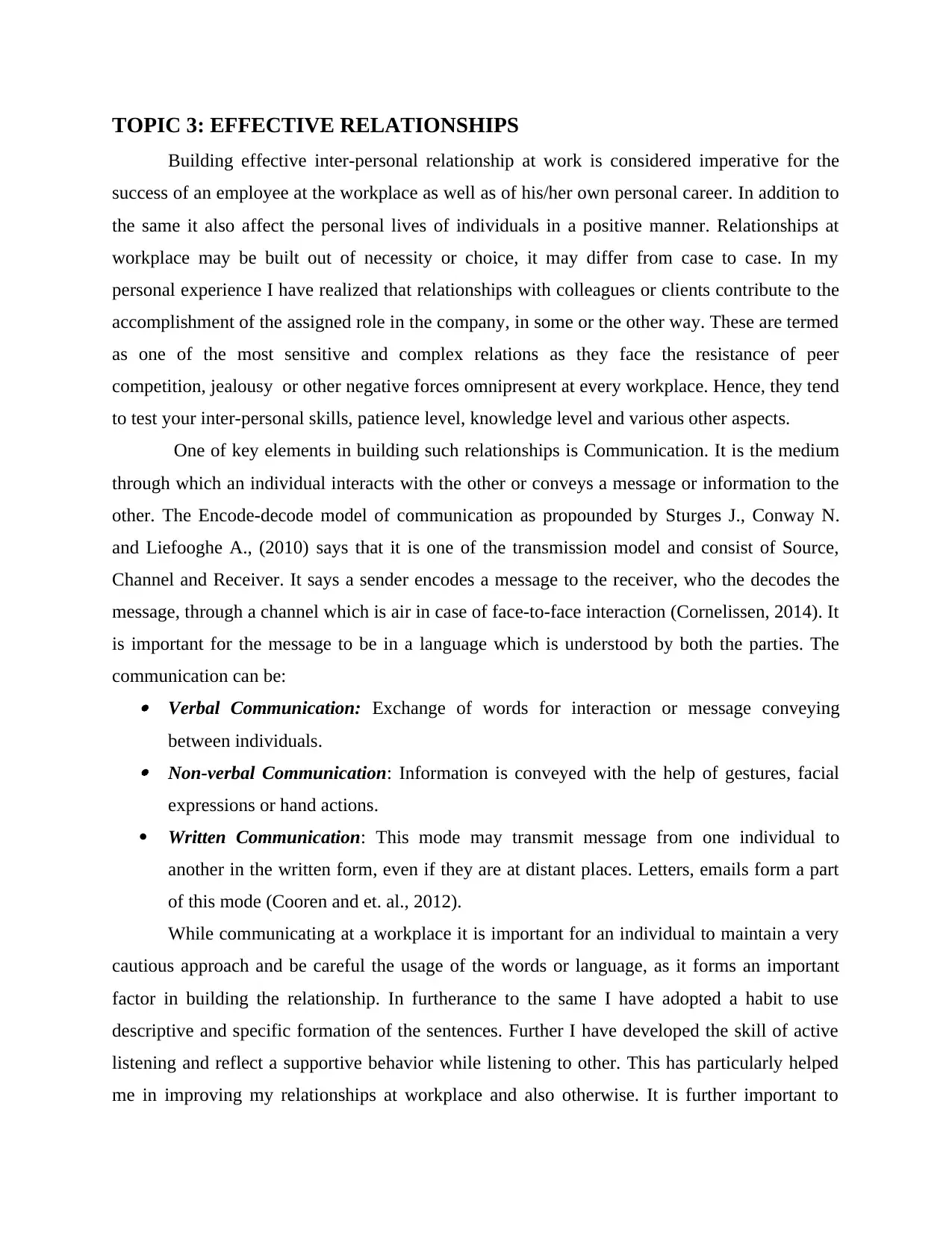
TOPIC 3: EFFECTIVE RELATIONSHIPS
Building effective inter-personal relationship at work is considered imperative for the
success of an employee at the workplace as well as of his/her own personal career. In addition to
the same it also affect the personal lives of individuals in a positive manner. Relationships at
workplace may be built out of necessity or choice, it may differ from case to case. In my
personal experience I have realized that relationships with colleagues or clients contribute to the
accomplishment of the assigned role in the company, in some or the other way. These are termed
as one of the most sensitive and complex relations as they face the resistance of peer
competition, jealousy or other negative forces omnipresent at every workplace. Hence, they tend
to test your inter-personal skills, patience level, knowledge level and various other aspects.
One of key elements in building such relationships is Communication. It is the medium
through which an individual interacts with the other or conveys a message or information to the
other. The Encode-decode model of communication as propounded by Sturges J., Conway N.
and Liefooghe A., (2010) says that it is one of the transmission model and consist of Source,
Channel and Receiver. It says a sender encodes a message to the receiver, who the decodes the
message, through a channel which is air in case of face-to-face interaction (Cornelissen, 2014). It
is important for the message to be in a language which is understood by both the parties. The
communication can be: Verbal Communication: Exchange of words for interaction or message conveying
between individuals. Non-verbal Communication: Information is conveyed with the help of gestures, facial
expressions or hand actions.
Written Communication: This mode may transmit message from one individual to
another in the written form, even if they are at distant places. Letters, emails form a part
of this mode (Cooren and et. al., 2012).
While communicating at a workplace it is important for an individual to maintain a very
cautious approach and be careful the usage of the words or language, as it forms an important
factor in building the relationship. In furtherance to the same I have adopted a habit to use
descriptive and specific formation of the sentences. Further I have developed the skill of active
listening and reflect a supportive behavior while listening to other. This has particularly helped
me in improving my relationships at workplace and also otherwise. It is further important to
Building effective inter-personal relationship at work is considered imperative for the
success of an employee at the workplace as well as of his/her own personal career. In addition to
the same it also affect the personal lives of individuals in a positive manner. Relationships at
workplace may be built out of necessity or choice, it may differ from case to case. In my
personal experience I have realized that relationships with colleagues or clients contribute to the
accomplishment of the assigned role in the company, in some or the other way. These are termed
as one of the most sensitive and complex relations as they face the resistance of peer
competition, jealousy or other negative forces omnipresent at every workplace. Hence, they tend
to test your inter-personal skills, patience level, knowledge level and various other aspects.
One of key elements in building such relationships is Communication. It is the medium
through which an individual interacts with the other or conveys a message or information to the
other. The Encode-decode model of communication as propounded by Sturges J., Conway N.
and Liefooghe A., (2010) says that it is one of the transmission model and consist of Source,
Channel and Receiver. It says a sender encodes a message to the receiver, who the decodes the
message, through a channel which is air in case of face-to-face interaction (Cornelissen, 2014). It
is important for the message to be in a language which is understood by both the parties. The
communication can be: Verbal Communication: Exchange of words for interaction or message conveying
between individuals. Non-verbal Communication: Information is conveyed with the help of gestures, facial
expressions or hand actions.
Written Communication: This mode may transmit message from one individual to
another in the written form, even if they are at distant places. Letters, emails form a part
of this mode (Cooren and et. al., 2012).
While communicating at a workplace it is important for an individual to maintain a very
cautious approach and be careful the usage of the words or language, as it forms an important
factor in building the relationship. In furtherance to the same I have adopted a habit to use
descriptive and specific formation of the sentences. Further I have developed the skill of active
listening and reflect a supportive behavior while listening to other. This has particularly helped
me in improving my relationships at workplace and also otherwise. It is further important to
⊘ This is a preview!⊘
Do you want full access?
Subscribe today to unlock all pages.

Trusted by 1+ million students worldwide
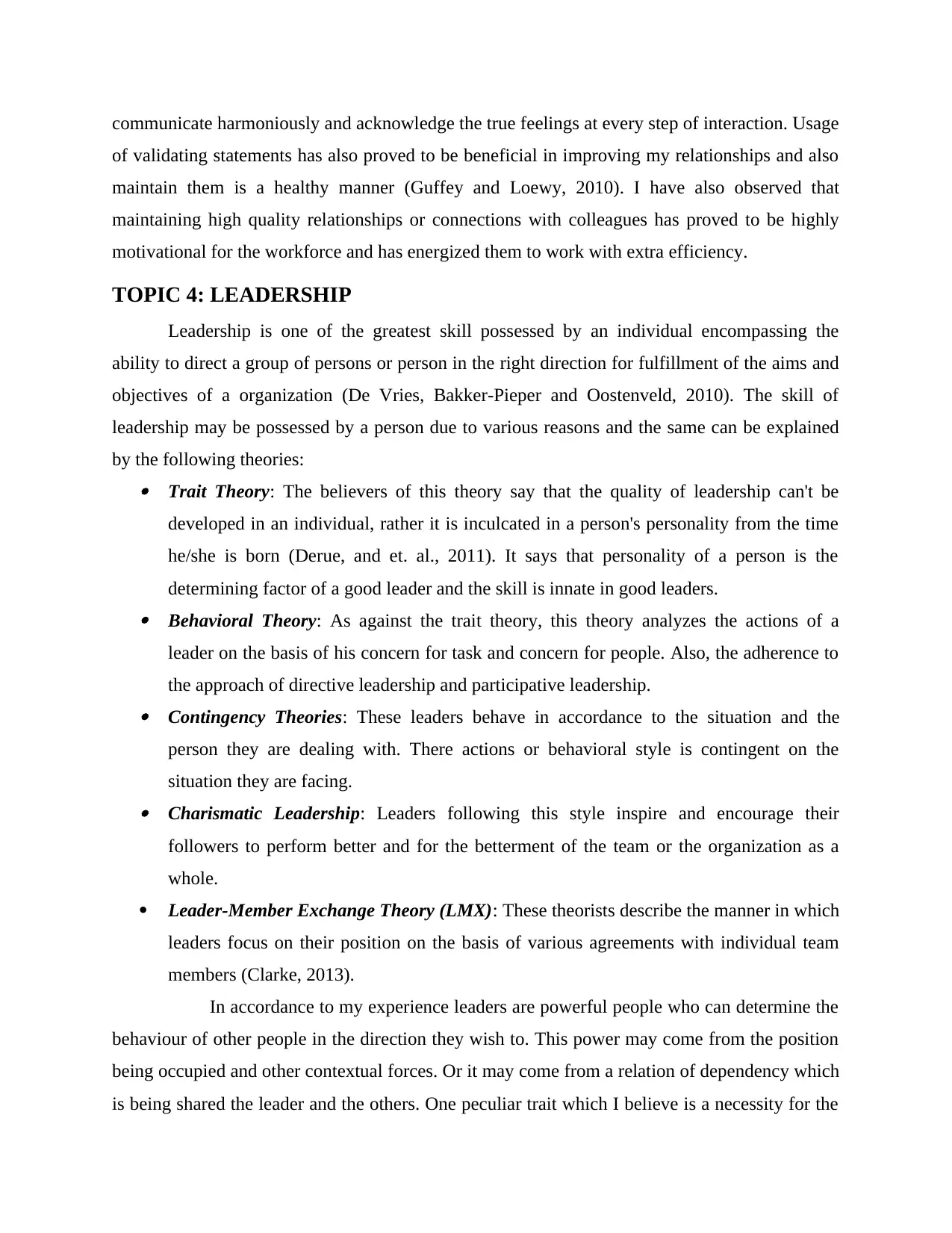
communicate harmoniously and acknowledge the true feelings at every step of interaction. Usage
of validating statements has also proved to be beneficial in improving my relationships and also
maintain them is a healthy manner (Guffey and Loewy, 2010). I have also observed that
maintaining high quality relationships or connections with colleagues has proved to be highly
motivational for the workforce and has energized them to work with extra efficiency.
TOPIC 4: LEADERSHIP
Leadership is one of the greatest skill possessed by an individual encompassing the
ability to direct a group of persons or person in the right direction for fulfillment of the aims and
objectives of a organization (De Vries, Bakker-Pieper and Oostenveld, 2010). The skill of
leadership may be possessed by a person due to various reasons and the same can be explained
by the following theories: Trait Theory: The believers of this theory say that the quality of leadership can't be
developed in an individual, rather it is inculcated in a person's personality from the time
he/she is born (Derue, and et. al., 2011). It says that personality of a person is the
determining factor of a good leader and the skill is innate in good leaders. Behavioral Theory: As against the trait theory, this theory analyzes the actions of a
leader on the basis of his concern for task and concern for people. Also, the adherence to
the approach of directive leadership and participative leadership. Contingency Theories: These leaders behave in accordance to the situation and the
person they are dealing with. There actions or behavioral style is contingent on the
situation they are facing. Charismatic Leadership: Leaders following this style inspire and encourage their
followers to perform better and for the betterment of the team or the organization as a
whole.
Leader-Member Exchange Theory (LMX): These theorists describe the manner in which
leaders focus on their position on the basis of various agreements with individual team
members (Clarke, 2013).
In accordance to my experience leaders are powerful people who can determine the
behaviour of other people in the direction they wish to. This power may come from the position
being occupied and other contextual forces. Or it may come from a relation of dependency which
is being shared the leader and the others. One peculiar trait which I believe is a necessity for the
of validating statements has also proved to be beneficial in improving my relationships and also
maintain them is a healthy manner (Guffey and Loewy, 2010). I have also observed that
maintaining high quality relationships or connections with colleagues has proved to be highly
motivational for the workforce and has energized them to work with extra efficiency.
TOPIC 4: LEADERSHIP
Leadership is one of the greatest skill possessed by an individual encompassing the
ability to direct a group of persons or person in the right direction for fulfillment of the aims and
objectives of a organization (De Vries, Bakker-Pieper and Oostenveld, 2010). The skill of
leadership may be possessed by a person due to various reasons and the same can be explained
by the following theories: Trait Theory: The believers of this theory say that the quality of leadership can't be
developed in an individual, rather it is inculcated in a person's personality from the time
he/she is born (Derue, and et. al., 2011). It says that personality of a person is the
determining factor of a good leader and the skill is innate in good leaders. Behavioral Theory: As against the trait theory, this theory analyzes the actions of a
leader on the basis of his concern for task and concern for people. Also, the adherence to
the approach of directive leadership and participative leadership. Contingency Theories: These leaders behave in accordance to the situation and the
person they are dealing with. There actions or behavioral style is contingent on the
situation they are facing. Charismatic Leadership: Leaders following this style inspire and encourage their
followers to perform better and for the betterment of the team or the organization as a
whole.
Leader-Member Exchange Theory (LMX): These theorists describe the manner in which
leaders focus on their position on the basis of various agreements with individual team
members (Clarke, 2013).
In accordance to my experience leaders are powerful people who can determine the
behaviour of other people in the direction they wish to. This power may come from the position
being occupied and other contextual forces. Or it may come from a relation of dependency which
is being shared the leader and the others. One peculiar trait which I believe is a necessity for the
Paraphrase This Document
Need a fresh take? Get an instant paraphrase of this document with our AI Paraphraser
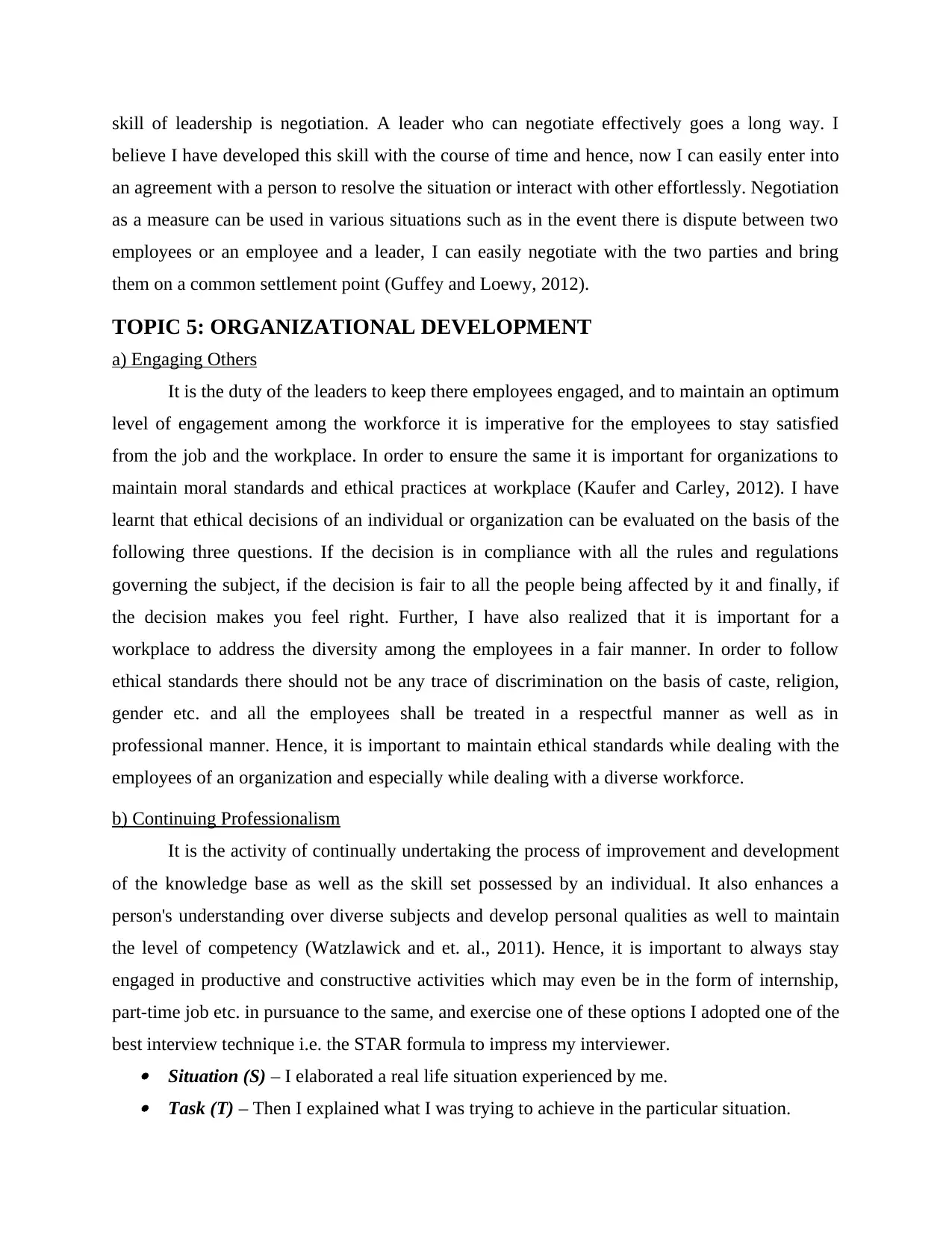
skill of leadership is negotiation. A leader who can negotiate effectively goes a long way. I
believe I have developed this skill with the course of time and hence, now I can easily enter into
an agreement with a person to resolve the situation or interact with other effortlessly. Negotiation
as a measure can be used in various situations such as in the event there is dispute between two
employees or an employee and a leader, I can easily negotiate with the two parties and bring
them on a common settlement point (Guffey and Loewy, 2012).
TOPIC 5: ORGANIZATIONAL DEVELOPMENT
a) Engaging Others
It is the duty of the leaders to keep there employees engaged, and to maintain an optimum
level of engagement among the workforce it is imperative for the employees to stay satisfied
from the job and the workplace. In order to ensure the same it is important for organizations to
maintain moral standards and ethical practices at workplace (Kaufer and Carley, 2012). I have
learnt that ethical decisions of an individual or organization can be evaluated on the basis of the
following three questions. If the decision is in compliance with all the rules and regulations
governing the subject, if the decision is fair to all the people being affected by it and finally, if
the decision makes you feel right. Further, I have also realized that it is important for a
workplace to address the diversity among the employees in a fair manner. In order to follow
ethical standards there should not be any trace of discrimination on the basis of caste, religion,
gender etc. and all the employees shall be treated in a respectful manner as well as in
professional manner. Hence, it is important to maintain ethical standards while dealing with the
employees of an organization and especially while dealing with a diverse workforce.
b) Continuing Professionalism
It is the activity of continually undertaking the process of improvement and development
of the knowledge base as well as the skill set possessed by an individual. It also enhances a
person's understanding over diverse subjects and develop personal qualities as well to maintain
the level of competency (Watzlawick and et. al., 2011). Hence, it is important to always stay
engaged in productive and constructive activities which may even be in the form of internship,
part-time job etc. in pursuance to the same, and exercise one of these options I adopted one of the
best interview technique i.e. the STAR formula to impress my interviewer. Situation (S) – I elaborated a real life situation experienced by me. Task (T) – Then I explained what I was trying to achieve in the particular situation.
believe I have developed this skill with the course of time and hence, now I can easily enter into
an agreement with a person to resolve the situation or interact with other effortlessly. Negotiation
as a measure can be used in various situations such as in the event there is dispute between two
employees or an employee and a leader, I can easily negotiate with the two parties and bring
them on a common settlement point (Guffey and Loewy, 2012).
TOPIC 5: ORGANIZATIONAL DEVELOPMENT
a) Engaging Others
It is the duty of the leaders to keep there employees engaged, and to maintain an optimum
level of engagement among the workforce it is imperative for the employees to stay satisfied
from the job and the workplace. In order to ensure the same it is important for organizations to
maintain moral standards and ethical practices at workplace (Kaufer and Carley, 2012). I have
learnt that ethical decisions of an individual or organization can be evaluated on the basis of the
following three questions. If the decision is in compliance with all the rules and regulations
governing the subject, if the decision is fair to all the people being affected by it and finally, if
the decision makes you feel right. Further, I have also realized that it is important for a
workplace to address the diversity among the employees in a fair manner. In order to follow
ethical standards there should not be any trace of discrimination on the basis of caste, religion,
gender etc. and all the employees shall be treated in a respectful manner as well as in
professional manner. Hence, it is important to maintain ethical standards while dealing with the
employees of an organization and especially while dealing with a diverse workforce.
b) Continuing Professionalism
It is the activity of continually undertaking the process of improvement and development
of the knowledge base as well as the skill set possessed by an individual. It also enhances a
person's understanding over diverse subjects and develop personal qualities as well to maintain
the level of competency (Watzlawick and et. al., 2011). Hence, it is important to always stay
engaged in productive and constructive activities which may even be in the form of internship,
part-time job etc. in pursuance to the same, and exercise one of these options I adopted one of the
best interview technique i.e. the STAR formula to impress my interviewer. Situation (S) – I elaborated a real life situation experienced by me. Task (T) – Then I explained what I was trying to achieve in the particular situation.
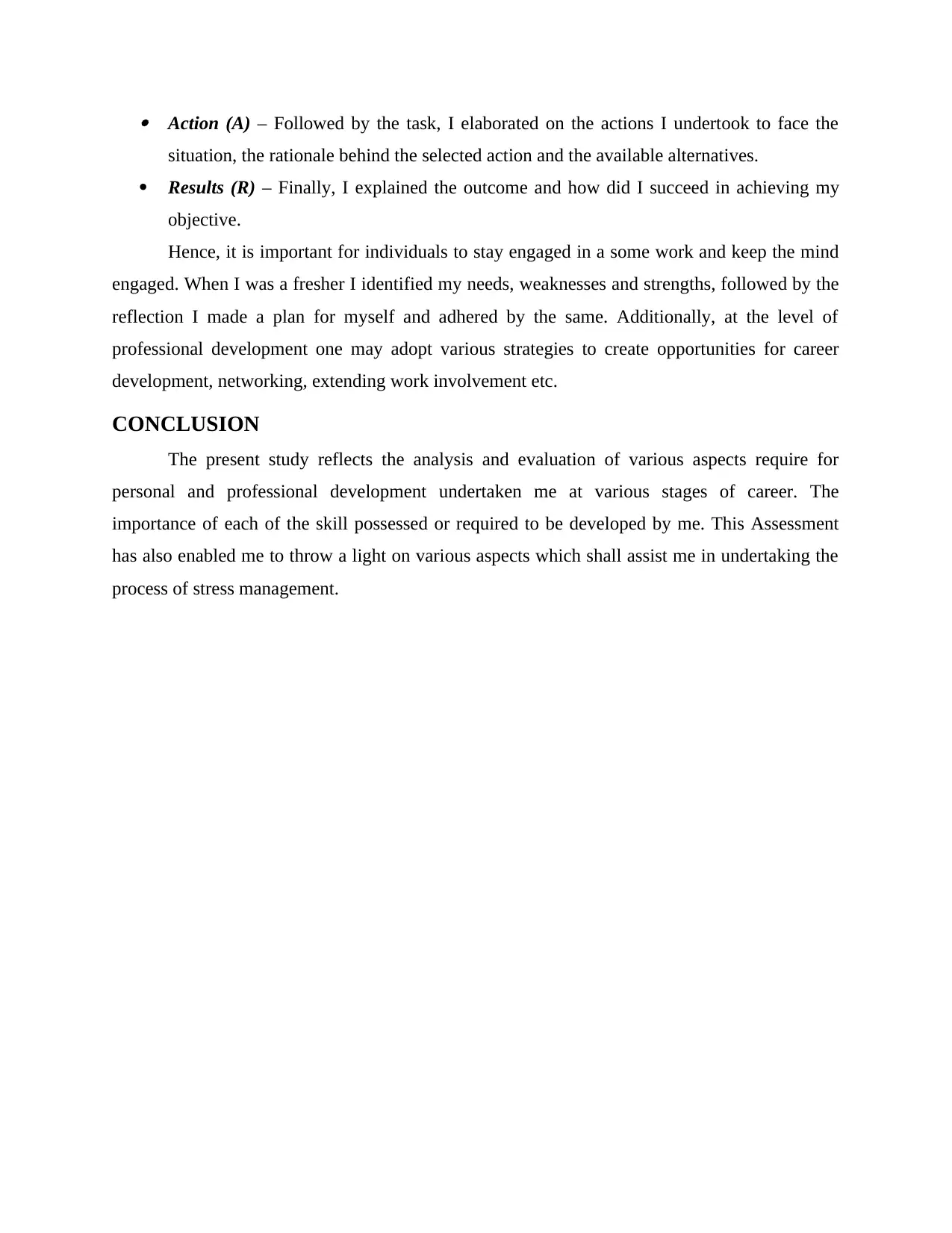
Action (A) – Followed by the task, I elaborated on the actions I undertook to face the
situation, the rationale behind the selected action and the available alternatives.
Results (R) – Finally, I explained the outcome and how did I succeed in achieving my
objective.
Hence, it is important for individuals to stay engaged in a some work and keep the mind
engaged. When I was a fresher I identified my needs, weaknesses and strengths, followed by the
reflection I made a plan for myself and adhered by the same. Additionally, at the level of
professional development one may adopt various strategies to create opportunities for career
development, networking, extending work involvement etc.
CONCLUSION
The present study reflects the analysis and evaluation of various aspects require for
personal and professional development undertaken me at various stages of career. The
importance of each of the skill possessed or required to be developed by me. This Assessment
has also enabled me to throw a light on various aspects which shall assist me in undertaking the
process of stress management.
situation, the rationale behind the selected action and the available alternatives.
Results (R) – Finally, I explained the outcome and how did I succeed in achieving my
objective.
Hence, it is important for individuals to stay engaged in a some work and keep the mind
engaged. When I was a fresher I identified my needs, weaknesses and strengths, followed by the
reflection I made a plan for myself and adhered by the same. Additionally, at the level of
professional development one may adopt various strategies to create opportunities for career
development, networking, extending work involvement etc.
CONCLUSION
The present study reflects the analysis and evaluation of various aspects require for
personal and professional development undertaken me at various stages of career. The
importance of each of the skill possessed or required to be developed by me. This Assessment
has also enabled me to throw a light on various aspects which shall assist me in undertaking the
process of stress management.
⊘ This is a preview!⊘
Do you want full access?
Subscribe today to unlock all pages.

Trusted by 1+ million students worldwide
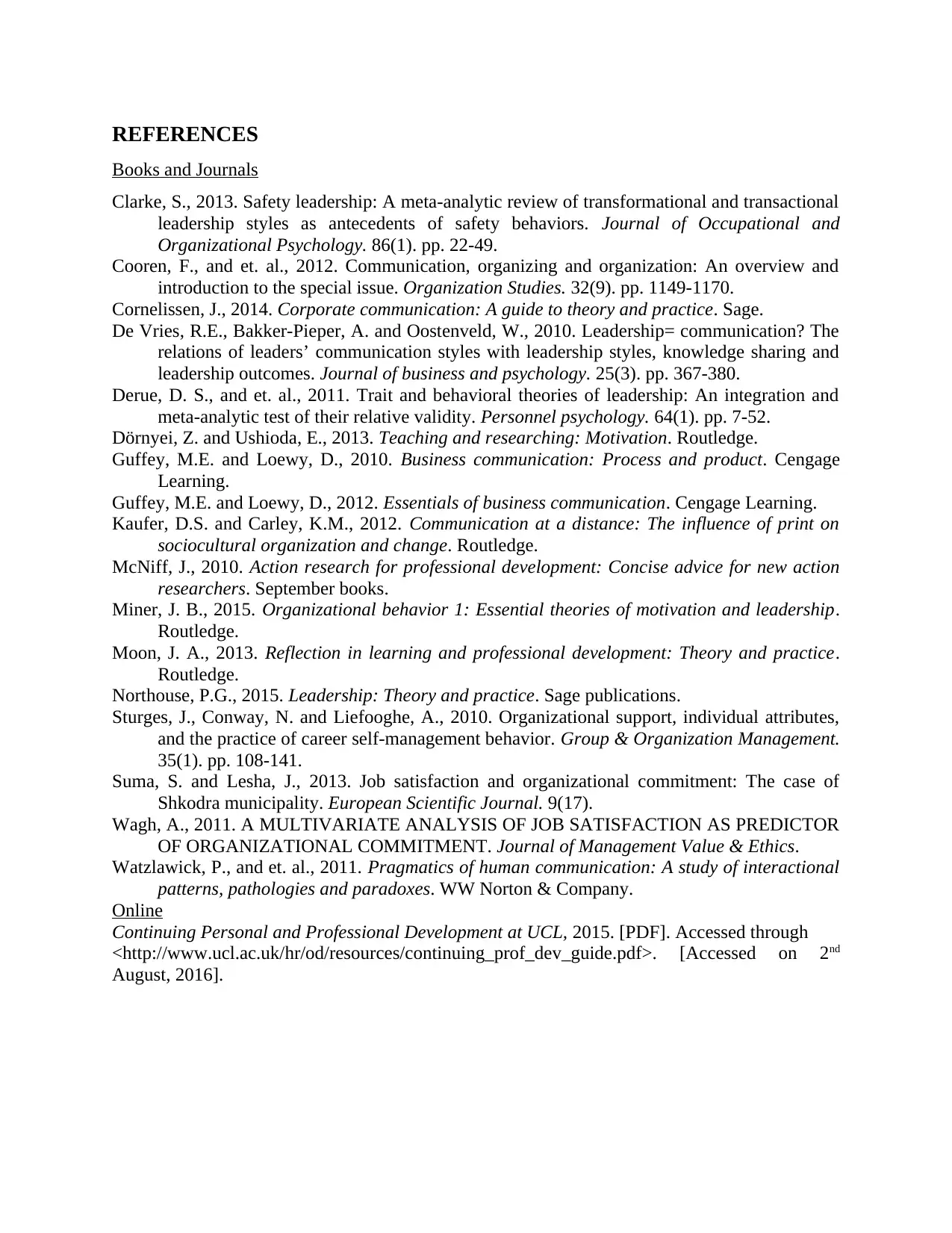
REFERENCES
Books and Journals
Clarke, S., 2013. Safety leadership: A meta‐analytic review of transformational and transactional
leadership styles as antecedents of safety behaviors. Journal of Occupational and
Organizational Psychology. 86(1). pp. 22-49.
Cooren, F., and et. al., 2012. Communication, organizing and organization: An overview and
introduction to the special issue. Organization Studies. 32(9). pp. 1149-1170.
Cornelissen, J., 2014. Corporate communication: A guide to theory and practice. Sage.
De Vries, R.E., Bakker-Pieper, A. and Oostenveld, W., 2010. Leadership= communication? The
relations of leaders’ communication styles with leadership styles, knowledge sharing and
leadership outcomes. Journal of business and psychology. 25(3). pp. 367-380.
Derue, D. S., and et. al., 2011. Trait and behavioral theories of leadership: An integration and
meta‐analytic test of their relative validity. Personnel psychology. 64(1). pp. 7-52.
Dörnyei, Z. and Ushioda, E., 2013. Teaching and researching: Motivation. Routledge.
Guffey, M.E. and Loewy, D., 2010. Business communication: Process and product. Cengage
Learning.
Guffey, M.E. and Loewy, D., 2012. Essentials of business communication. Cengage Learning.
Kaufer, D.S. and Carley, K.M., 2012. Communication at a distance: The influence of print on
sociocultural organization and change. Routledge.
McNiff, J., 2010. Action research for professional development: Concise advice for new action
researchers. September books.
Miner, J. B., 2015. Organizational behavior 1: Essential theories of motivation and leadership.
Routledge.
Moon, J. A., 2013. Reflection in learning and professional development: Theory and practice.
Routledge.
Northouse, P.G., 2015. Leadership: Theory and practice. Sage publications.
Sturges, J., Conway, N. and Liefooghe, A., 2010. Organizational support, individual attributes,
and the practice of career self-management behavior. Group & Organization Management.
35(1). pp. 108-141.
Suma, S. and Lesha, J., 2013. Job satisfaction and organizational commitment: The case of
Shkodra municipality. European Scientific Journal. 9(17).
Wagh, A., 2011. A MULTIVARIATE ANALYSIS OF JOB SATISFACTION AS PREDICTOR
OF ORGANIZATIONAL COMMITMENT. Journal of Management Value & Ethics.
Watzlawick, P., and et. al., 2011. Pragmatics of human communication: A study of interactional
patterns, pathologies and paradoxes. WW Norton & Company.
Online
Continuing Personal and Professional Development at UCL, 2015. [PDF]. Accessed through
<http://www.ucl.ac.uk/hr/od/resources/continuing_prof_dev_guide.pdf>. [Accessed on 2nd
August, 2016].
Books and Journals
Clarke, S., 2013. Safety leadership: A meta‐analytic review of transformational and transactional
leadership styles as antecedents of safety behaviors. Journal of Occupational and
Organizational Psychology. 86(1). pp. 22-49.
Cooren, F., and et. al., 2012. Communication, organizing and organization: An overview and
introduction to the special issue. Organization Studies. 32(9). pp. 1149-1170.
Cornelissen, J., 2014. Corporate communication: A guide to theory and practice. Sage.
De Vries, R.E., Bakker-Pieper, A. and Oostenveld, W., 2010. Leadership= communication? The
relations of leaders’ communication styles with leadership styles, knowledge sharing and
leadership outcomes. Journal of business and psychology. 25(3). pp. 367-380.
Derue, D. S., and et. al., 2011. Trait and behavioral theories of leadership: An integration and
meta‐analytic test of their relative validity. Personnel psychology. 64(1). pp. 7-52.
Dörnyei, Z. and Ushioda, E., 2013. Teaching and researching: Motivation. Routledge.
Guffey, M.E. and Loewy, D., 2010. Business communication: Process and product. Cengage
Learning.
Guffey, M.E. and Loewy, D., 2012. Essentials of business communication. Cengage Learning.
Kaufer, D.S. and Carley, K.M., 2012. Communication at a distance: The influence of print on
sociocultural organization and change. Routledge.
McNiff, J., 2010. Action research for professional development: Concise advice for new action
researchers. September books.
Miner, J. B., 2015. Organizational behavior 1: Essential theories of motivation and leadership.
Routledge.
Moon, J. A., 2013. Reflection in learning and professional development: Theory and practice.
Routledge.
Northouse, P.G., 2015. Leadership: Theory and practice. Sage publications.
Sturges, J., Conway, N. and Liefooghe, A., 2010. Organizational support, individual attributes,
and the practice of career self-management behavior. Group & Organization Management.
35(1). pp. 108-141.
Suma, S. and Lesha, J., 2013. Job satisfaction and organizational commitment: The case of
Shkodra municipality. European Scientific Journal. 9(17).
Wagh, A., 2011. A MULTIVARIATE ANALYSIS OF JOB SATISFACTION AS PREDICTOR
OF ORGANIZATIONAL COMMITMENT. Journal of Management Value & Ethics.
Watzlawick, P., and et. al., 2011. Pragmatics of human communication: A study of interactional
patterns, pathologies and paradoxes. WW Norton & Company.
Online
Continuing Personal and Professional Development at UCL, 2015. [PDF]. Accessed through
<http://www.ucl.ac.uk/hr/od/resources/continuing_prof_dev_guide.pdf>. [Accessed on 2nd
August, 2016].
1 out of 10
Related Documents
Your All-in-One AI-Powered Toolkit for Academic Success.
+13062052269
info@desklib.com
Available 24*7 on WhatsApp / Email
![[object Object]](/_next/static/media/star-bottom.7253800d.svg)
Unlock your academic potential
Copyright © 2020–2025 A2Z Services. All Rights Reserved. Developed and managed by ZUCOL.





